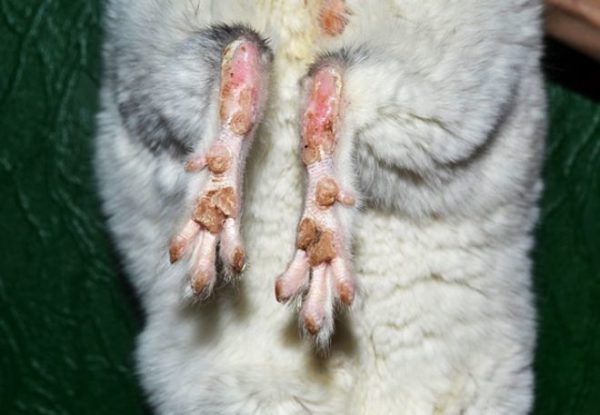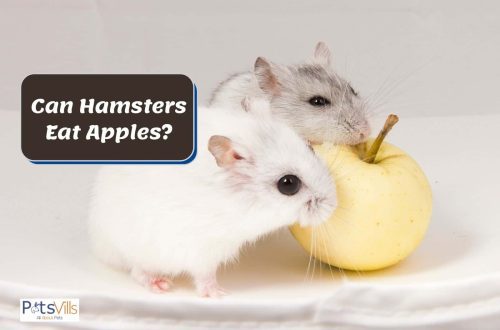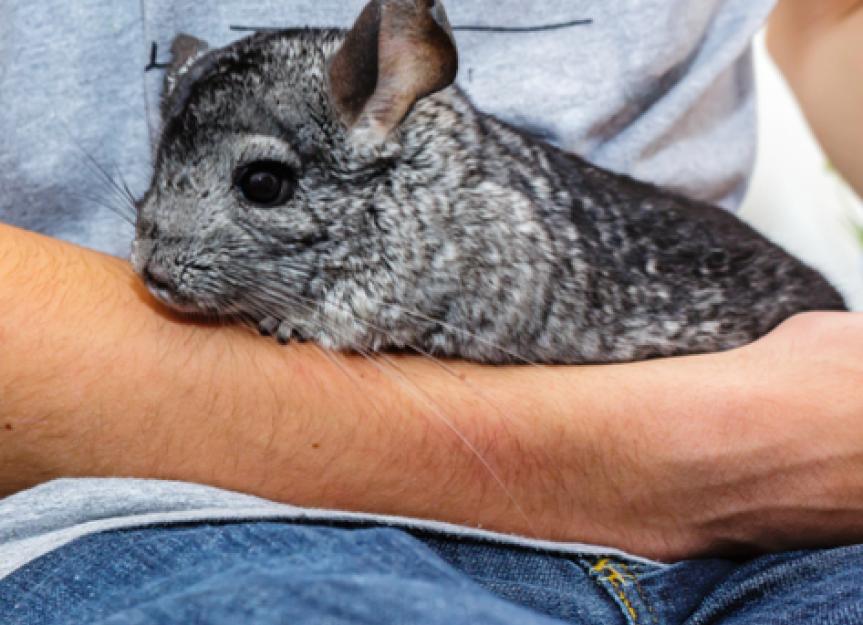
Šinšilų ligos: dažnų ligų simptomai ir gydymas namuose
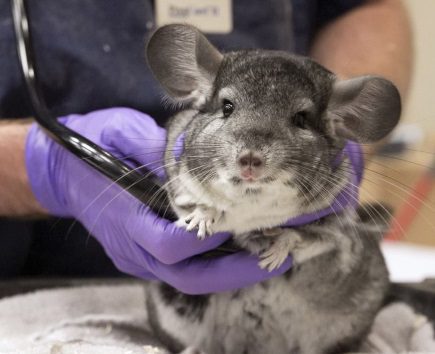
Domestic chinchillas inherited good health from their wild relatives living in a cool mountain climate. At home, chinchilla diseases often occur when the optimal microclimate and proper nutrition of funny pets are violated. The body of unusual rodents is characterized by an increased metabolism, so the pathologies of chinchillas are characterized by a rapid course, the development of complications and the death of the animal in the absence of timely therapeutic measures.
Turinys
- How to understand that a chinchilla is sick
- Infectious diseases of chinchillas
- Parasitic diseases of chinchillas
- Non-communicable diseases of chinchillas
- Virškinimo trakto ligos
- Kvėpavimo sistemos ligos
- Diseases of the genitourinary system and mammary glands
- Dantų patologijos
- Diseases of the eyes and ears
- Feeding a sick chinchilla
- prevencines priemones
- skiepai
How to understand that a chinchilla is sick
An attentive owner can guess that the chinchilla fell ill by a change in the usual behavior of a beloved animal and external signs of a manifestation of pathology.
A healthy rodent has:
- geras apetitas;
- high activity and adequate response to the caresses of the owner;
- shiny dry eyes;
- clean nose;
- ears are clean, without scabs and dirt;
- bright orange straight teeth;
- shiny smooth thick fur;
- stable weight of adults 450 – 650 g, depending on the breed and sex;
- oblong round litter;
- clean genitals.
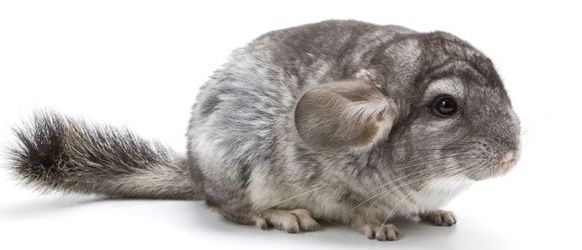
You can understand that your beloved animal feels bad by the characteristic symptoms:
- letargija, apatija;
- the animal refuses food and water;
- eyes are moist, swollen, lacrimation is observed;
- ears are red, hot, peeling on the skin of the auricle, scabs, dark discharge;
- mucous discharge or dried crusts in the nose;
- sneezing, coughing, wheezing, heavy breathing;
- mouth ajar, profuse salivation, vomiting;
- hair loss, the formation of extensive areas of baldness, wetting of wool, trimmed fur;
- urine with bloody secretions;
- eczema on the skin, corns on the feet;

If hygiene is not observed in the cage, corns may occur - dry small or liquid foamy litter, lack of bowel movements;
- svorio metimas;
- impaired coordination, convulsions, paralysis of the limbs;
- secretions from the genitals, hair rings in males.
IMPORTANT!!! With any change in behavior, refusal of food or the appearance of external signs of illness of the animal, it is necessary to immediately consult a veterinarian. Loss of time and self-treatment can cause the death of a chinchilla or infection of family members!
Owners of domestic rodents need to know what can be infected from a chinchilla, dangerous diseases for humans: lymphocytic choriomeningitis, listeriosis, rabies, tuberculosis, toxoplasmosis, trichophytosis and microsporia.
Infectious diseases of chinchillas
Chinchillas become infected with infectious diseases even at home with good care and maintenance through:
- contaminated feed, water and litter;
- bites of blood-sucking and arachnid insects;
- contact with sick animals.
Fluffy animals most often get paratyphoid, listeriosis, tuberculosis, pseudotuberculosis, streptococcosis.
Such pathologies are characterized by a severe course and often a fatal outcome.
Treatment of infectious diseases of chinchillas is carried out only by a veterinarian after a comprehensive examination of the fluffy animal, clarification of the diagnosis and clarification of the cause of the disease. Many pathologies require the appointment of specific drugs or the euthanasia of an infected animal.
Tuberkuliozė
Domestic chinchillas become infected with tuberculosis by ingesting infected cow’s milk or through contact with sick animals. The causative agent of the disease is a tubercle bacillus. Pathology is very dangerous for a person. In fluffy pets, the most common form is the pulmonary form, less often the intestinal form. The disease ends with the death of the animal.
A sick chinchilla has:
- letargija;
- apatija;
- maisto atsisakymas;
- sunkus kvėpavimas;
- kosulys;
- dusulys;
- viduriavimas;
- svorio metimas.
The diagnosis is confirmed by tuberculinization. Infected pets are euthanized. Chinchillas that have been in contact with an infectious rodent are kept in quarantine.
Listeriozė
An infectious disease that most often infects pregnant females and newborn puppies through the use of animal feed obtained from sick animals. The causative agent of the pathology is Listerella. The disease is very dangerous for humans.
In sick chinchillas, it is noted:
- atsisakymas maitinti;
- padidėjusi kūno temperatūra;
- koordinavimo pažeidimai;
- endometritas;
- persileidimai;
- mummification of the fetus.
Sick rodents are destroyed. For chinchillas that have been in contact with an infectious animal, quarantine is established.
Grybelis
Ringworm is caused by pathogenic microscopic fungi. The name of the pathology combines two diseases – trichophytosis and microsporia. Infection of domestic chinchillas occurs through contact with infected dogs, cats, and humans. The disease is characterized by the formation of large rounded hairless zones with eczematous skin lesions. In the absence of timely treatment, rapid baldness of the domestic rodent occurs. Weakened animals and young animals may die. The disease is very dangerous for humans. The diagnosis is confirmed in a veterinary clinic by microscopic examination of skin scrapings. Treatment is based on the use of fungicidal preparations.
Parasitic diseases of chinchillas
In domestic chinchillas, ectoparasites are most often observed – lice, withers and ticks, worms and coccidia. Diagnosis and treatment of diseases must be carried out under the supervision of a veterinarian.
Ektoparazitai
Parasitization of lice, withers and ticks is accompanied by:
- severe itching and soreness in a chinchilla;
- a domestic rodent often itches, gnaws out fur;
- numerous scratches and inflamed wounds form on the skin;
- hair loss occurs.
Diseases are dangerous for the development of anemia and death. Treatment is based on the use of special anti-parasitic collars for cats or dwarf dogs.
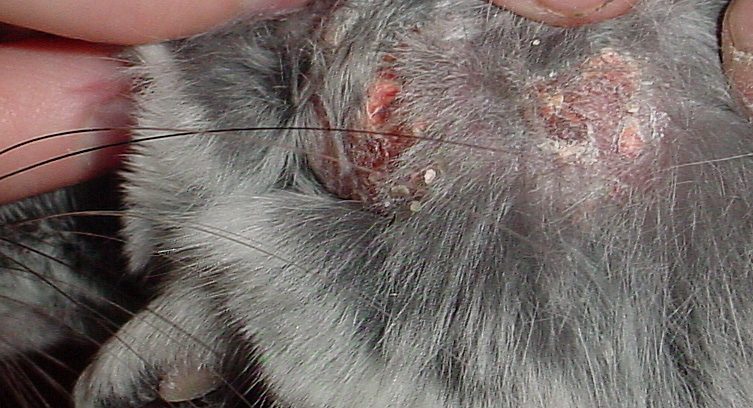
Kirminai
Worms in chinchillas parasitize in the internal organs: intestines, kidneys, liver, lungs. Migration of larvae is accompanied by inflammatory processes in the affected organs. Worms produce toxins that cause rapid emaciation and intoxication of a pet. Most often, giardia and cryptosporidium are found in domestic rodents.
A sick chinchilla has:
- viduriavimas;
- letargija;
- svorio metimas;
- detection of parasites in the feces.
Treatment is based on the use of antiparasitic drugs.
Kokcidiozė
Chinchillas become infected with coccidiosis through feed, litter, water, contact with sick animals. The causative agent of the disease is coccidia.
Pathology is characterized by:
- destruction of the mucous membrane of the small intestine of the animal;
- in a sick rodent, lethargy is observed;
- weight loss, diarrhea, constipation, bloating of the stomach and intestines;
- convulsions, paralysis of the limbs, often fatal.
The diagnosis is confirmed by the detection of eggs of the pathogen in the feces of chinchillas. Sick pets are treated with sulfa drugs.
Non-communicable diseases of chinchillas
Non-contagious diseases in chinchillas occur when the conditions of feeding and keeping are violated.
What do chinchillas get sick through the fault of inexperienced owners? In domestic rodents, the most common are:
- stresas;
- pathology of the teeth of the gastrointestinal tract, cardiovascular and respiratory systems;
- skin and colds;
- alergijos;
- sužalojimų.
It is recommended to treat a chinchilla under the supervision of a veterinarian, preferably an experienced rodentologist.
Šalta
A cold in chinchillas occurs as a result of keeping animals in a draft or when the air temperature in the room drops below +15 degrees. The disease manifests itself:
- maisto atsisakymas;
- letargija;
- tepimas;
- čiaudulys ir kosulys;
- išskyros iš nosies;
- kūno temperatūros padidėjimas.
Body temperature above 39 C is deadly for chinchillas, therefore, at the first symptoms of the disease, it is necessary to urgently call a veterinarian.
During treatment, a course of antibacterial drugs, most often Baytril, and symptomatic drugs are prescribed.
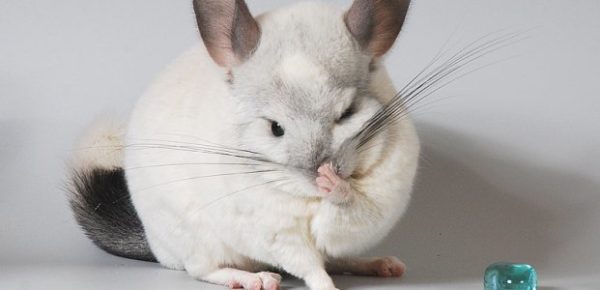
Stresas
Chinchillas react very emotionally to a change of scenery, loud sounds, the annoying attention of pets and children, the owner’s careless attitude, and the introduction of a new partner.
Sometimes fear can cause the sudden death of an exotic animal.
When stressed, the animal:
- sluggish and oppressed;
- gnaws its tail;
- there is a refusal of food and hair loss.
When stressed, it is necessary to place a frightened animal in a separate cage, create a quiet, comfortable environment, treat it to your favorite treat and give it time to calm down.
Šilumos smūgis
The optimal conditions for keeping domestic chinchillas is the air temperature in the room + 18-20 degrees with a humidity not higher than 60%. Air temperature above +25 degrees is detrimental to small pets. With heat stroke, animals are depressed, breathe heavily, refuse to feed, and mass death of exotic animals is often observed. In case of overheating, it is necessary to place the pet in a cool room, excluding the possibility of animals being in drafts. For resuscitation of the animal, drugs that support cardiovascular and respiratory activity are used.
Traumos
Keeping several animals in one cage is often accompanied by fights and various injuries. It is enough to treat scratches and small skin lesions at home with a solution of hydrogen peroxide and Levomekol anti-inflammatory ointment.
If the chinchilla has fallen from a high shelf, or the chinchilla has broken its hind or front paw, it is urgent to contact a specialist. Closed fractures are successfully treated by splinting the injured limb so that the bones can heal properly. After removing the splint, slight lameness or lack of mobility of the fingers is allowed.
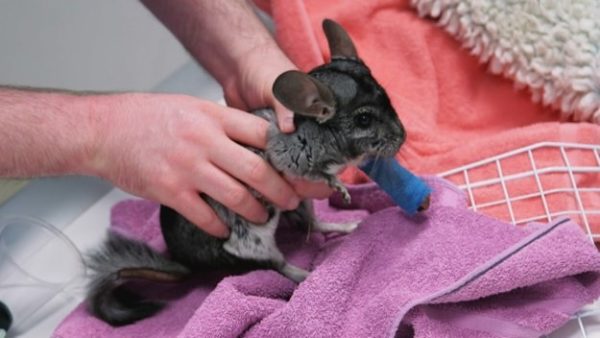
Self-treatment of fractures is highly discouraged. If the splint is applied incorrectly, the animal gnaws off the disturbing paw. Open fractures of the extremities are an indication for amputation of the paw with anesthesia and suturing, followed by postoperative wound debridement.
If the tip of the chinchilla’s tail came off when the pet was carelessly pulled out of the cage, it is necessary to stop the bleeding and treat the wound with a hydrogen peroxide solution. In case of severe damage, it is urgent to contact a veterinary clinic for amputation of the tail with sutures.
Often chinchillas get a fracture of the spine, the result of an injury can be damage to the spinal cord, paralysis of the limbs and scoliosis. The diagnosis is confirmed by a comprehensive examination using x-rays and MRI.
If the integrity of the spinal cord is violated, the animal cannot be cured.
In steel cases, chinchillas are prescribed post-traumatic treatment, most often the consequences of the injury remain for life.
Virškinimo trakto ligos
Chinchillas are very prone to gastrointestinal diseases. The slightest non-compliance with the recommendations of experts on the proper nutrition of chinchillas can lead to the following pathologies.
Pilvo pūtimas
Bloating of the stomach and intestines in chinchillas, in the absence of appropriate treatment, can cause the rapid death of a fluffy pet. Flatulence occurs when a chinchilla eats gas-forming food – fresh cabbage, greens, spoiled food or wet hay.
Pathology is characterized by oppression, refusal of food and water, the animal is breathing heavily, the stomach is tense. Treatment involves a starvation diet, the use of carminatives, abdominal massage.
Užkietėjimas
Constipation is a pathology that is deadly for chinchillas, causing a rupture of the intestinal wall and the death of a pet.
The disease develops:
- with inactivity of a fluffy animal;
- eating predominantly concentrated feed;
- vandens trūkumas;
- stress and infectious diseases.
With constipation rodent:
- sits in a hunched position;
- makes groans;
- atsisako valgyti;
- no bowel movements;
- a clogged intestine can be felt through the abdomen.
It is recommended to drink vegetable oil to the pet, make it move, make a cleansing enema, feed it with fruits or herbs.
Viduriavimas
Diarrhea in chinchillas occurs:
- sergant infekcinėmis ligomis;
- helminto invazijos;
- overexcitation;
- consumption of moldy feed or poor quality water.
Diarrhea appears:
- frequent liquid fetid stools, sometimes mixed with mucus and blood;
- the animal is lethargic, refuses food and water.
For treatment, fixing decoctions of herbs, antibacterial and sulfacylamide preparations are used.
Tiesiosios žarnos prolapsas
Rectal prolapse in chinchillas is due to gastroenteritis or prolonged constipation. Treatment of pathology consists in the reduction of the intestine treated with paraffin oil and massage of the abdomen.
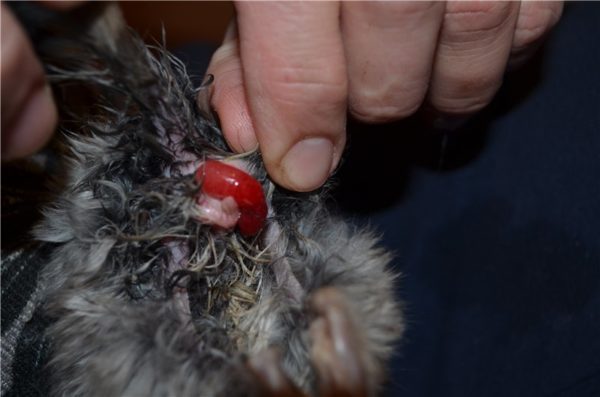
Gastroenteritas
Inflammation of the stomach and intestines in chinchillas develops with a sharp change in diet, the use of moldy feed, hay and poor-quality water.
The chinchilla has:
- apatija;
- letargija;
- atsisakymas maitinti;
- softening of feces.
For sick animals, a therapeutic diet is indicated.
Kvėpavimo sistemos ligos
Rinitas
Rhinitis in chinchillas occurs when keeping animals in a draft or dusty room.
A sick animal often:
- sneezes, rubs his muzzle with his paws;
- often sleeps, breathes heavily;
- there is mucous discharge from the nose and accumulation of white discharge in the corners of the eyes.
Gydymas apima:
- draft exclusion;
- wet cleaning;
- feeding your pet foods high in vitamin C;
- washing the eyes with a solution of boric acid;
- drinking rosehip syrup.
Plaučių uždegimas
Inflammation of the lungs develops with infectious diseases, complications of the common cold, and in newborn puppies. The disease is deadly for chinchillas.
With pneumonia, there is:
- padidėjusi kūno temperatūra;
- heavy breathing with wheezing and whistling;
- cough, lethargy, depression, refusal to feed.
Treatment is carried out with antibacterial and symptomatic drugs as prescribed by a veterinarian.
Diseases of the genitourinary system and mammary glands
Endometritas
Inflammation of the uterus in females is manifested by swelling and brown color of the vagina, as well as purulent discharge from the loop. For the treatment of pathology, a course of antibacterial drugs is simultaneously prescribed to the male and female.
plaukų žiedas
Hair rings around the penis in males are formed from wool during mating or insufficient hygiene of the animal. Squeezing the ring of the urinary canal can cause the death of a pet. Treatment consists in cutting the hair rings with scissors, followed by vaseline treatment of the squeezing site.
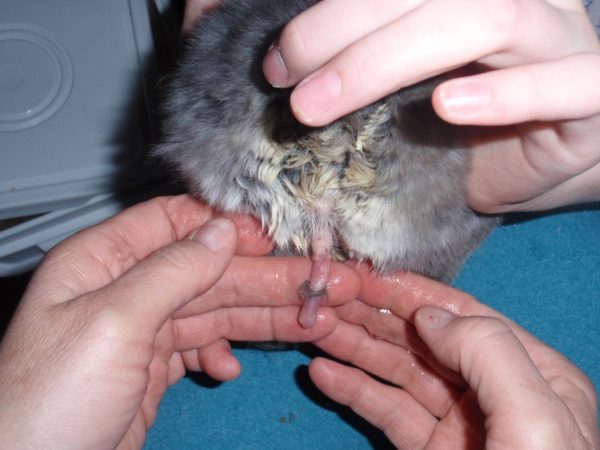
Mastitas
Inflammation of the mammary glands occurs when the nipples are damaged or milk stagnation in lactating females.
Patologija pasireiškia:
- weakness and refusal to eat;
- an increase in general and local body temperature;
- mammary glands swollen rough red or blue.
Treatment involves the use of antibacterial drugs and anti-inflammatory ointments, abscesses are opened surgically.
Urolitiazė
Pathology is most often observed in males; the development of the pathological process is facilitated by inactivity and feeding on dry food. A sick animal is worried, refuses to eat, urine is red. The diagnosis is made on the basis of a laboratory study of urine analysis and ultrasonographic examination. Antibiotic treatment is indicated for sand and small kidney stones, large stones are removed surgically.
Cistitas
Inflammation of the bladder occurs when the chinchilla is kept in a draft or the air temperature in the room drops below +15 C. In pathology, there is a frequent urge to urinate with the release of small portions of red urine. Treatment is based on the use of sulfa and diuretic drugs.
Dantų patologijos
Chinchillas can develop dental problems such as malocclusion and malocclusion.
Netinkamas įterpimas
Incorrect bite in chinchillas occurs when improper feeding or is inherited.
With dental pathology observed:
- seilėtekis;
- sorting out food;
- weight loss and loss of appetite;
- eating only soft food.
Treatment is carried out in a veterinary clinic under general anesthesia.
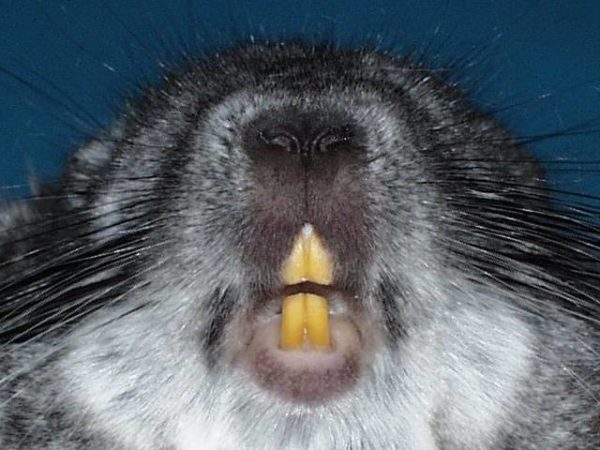
Netinkamas įterpimas
Malocclusion in chinchillas develops in the absence of roughage and mineral stones in the animal’s diet, metabolic disorders in the body, and inheritance. Pathology is characterized by the formation of sharp edges on the teeth and malocclusion.
Sick pet:
- išbarsto maistą;
- atsisako valgyti;
- there is incomplete closure of the jaws;
- seilėtekis;
- wetting of hair around the mouth;
- svorio metimas.
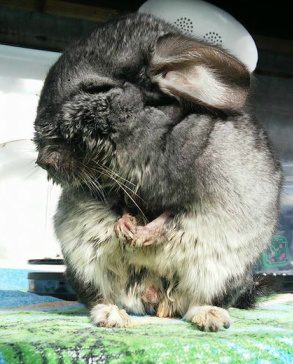
The treatment consists in cutting the teeth by a specialist in a veterinary clinic under general anesthesia.
Diseases of the eyes and ears
Konjunktyvitas
Inflammation of the mucous membrane of the eyes in chinchillas occurs with infectious diseases, colds, injuries or insufficient care. The chinchilla has swelling and redness of the eyelids, adhesion of the palpebral fissure with the formation of dried purulent crusts, mucous and purulent outflows from the eyes. Treatment includes washing the eye with antiseptic solutions and applying antibacterial ointments behind the eyelid.
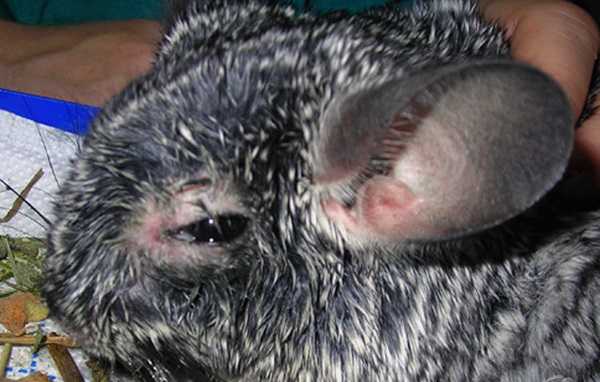
Otitas
Otitis in chinchillas develops with infectious diseases, keeping pets in drafts or a cold room.
Sick rodent:
- sluggish, tilts head to one side;
- rubs the ear against the walls of the cell;
- scratches ears with paws;
- the auricles are reddened, purulent discharge is observed.
Treatment of the disease consists in taking antibacterial drugs under the supervision of a veterinarian.
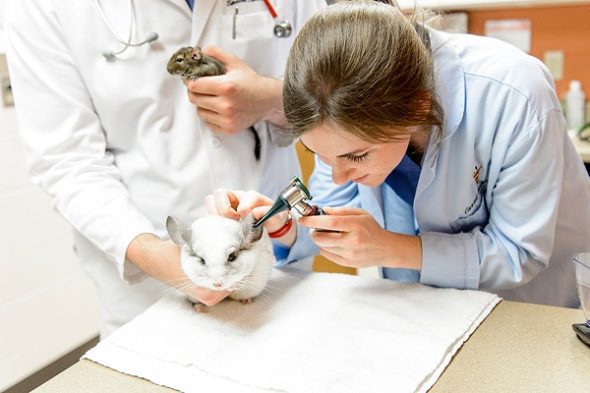
Feeding a sick chinchilla
Refusal to feed and drink is observed in many diseases, but loss of fluid and weight is deadly for small pets. The owner is recommended to drink the animal with isotonic solutions and feed soft puree food from a syringe. A prerequisite is the inclusion of vitamins for chinchillas and rosehip syrup, which increases the body’s defenses of a sick chinchilla.
prevencines priemones
Most chinchilla diseases occur when the rules of care are violated, therefore, the prevention of diseases of fluffy rodents is the proper conditions for feeding and keeping pets:
- daily cleaning of the cage or aviary, washing the feeder and drinker, hay filler and hay, disinfecting the cage and all accessories 2 times a week;
- high-quality feed, fresh dry hay, carefully selected berries and fruits, the correct proportions of concentrated and succulent feed;
- special bottled or filtered fresh water in sufficient quantity;
- mineral stones and branch food for proper grinding of teeth;
- tunnels, stairs, shelves, houses to ensure the necessary daily physical activity;
- the air temperature in the room is + 18-20 degrees and the humidity is not higher than 60%, the exclusion of drafts, direct sunlight on the cage;
- daily communication with the pet;
- timely detection of diseases and treatment of pathologies under the supervision of a veterinarian.
skiepai
Vaccination protects pets from most fungal and bacterial diseases. Chinchillas need to be vaccinated from 3 months of age. The vaccine is administered in two stages, the first injection provokes the manifestation of hidden pathologies, after two weeks the second injection of the drug is given, aimed at cleansing the blood of pathogenic bacteria and parasites.
In the future, fluffy animals must be vaccinated every 2 years.
Love and carefully observe your chinchillas, a caring owner will definitely notice lethargy, refusal to feed, or an outward manifestation of disease in a small pet. A timely appeal to a veterinarian can save a furry animal from serious complications and death, as well as prevent infection of the family with dangerous infectious diseases.
Treatment and symptoms of common chinchilla diseases
4.1 (82.86%) 7 balsai



